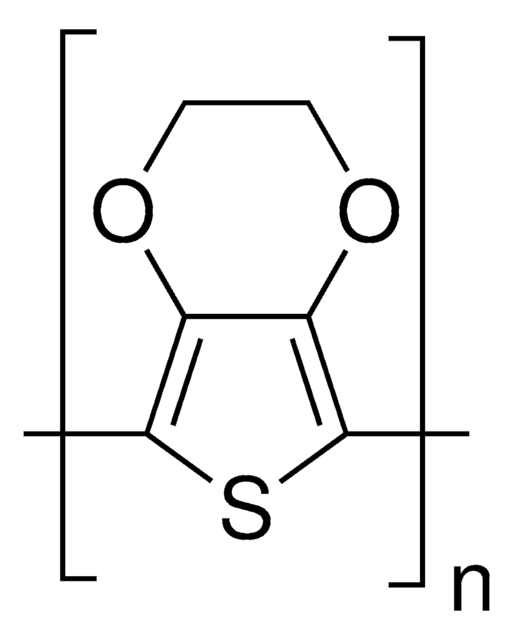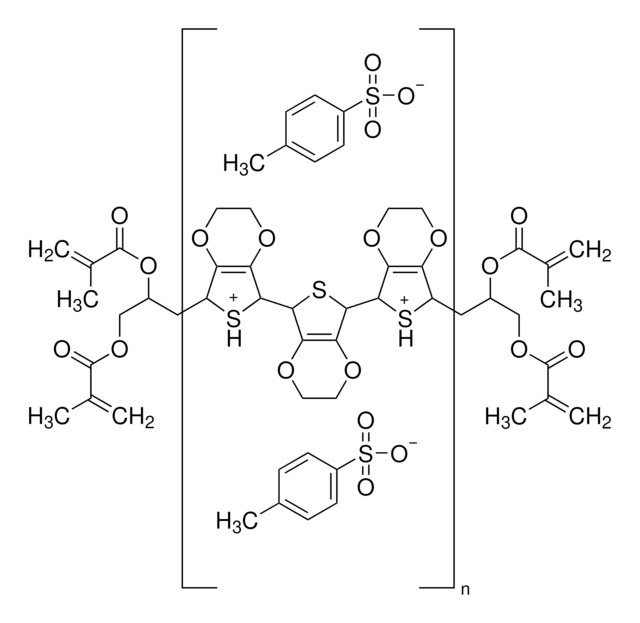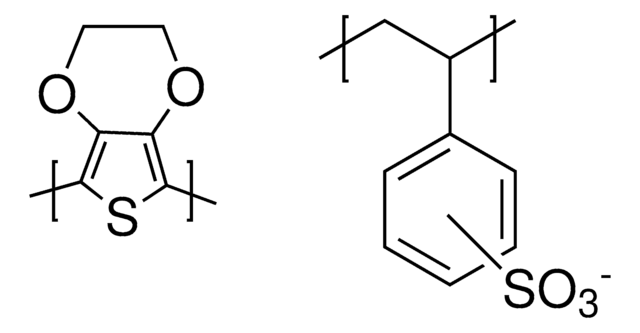736287
PEDOT
bis-PEG, lauryl terminated, 0.8 wt. % (propylene carbonate dispersion), contains perchlorate as dopant
Sinónimos:
Aedotron™ C3-NM, C12-PEG-block-PEDOT-block-PEG-C12
About This Item
Productos recomendados
product name
Poly(3,4-ethylenedioxythiophene), bis-poly(ethyleneglycol), lauryl terminated, 0.8 wt. % (dispersion in propylene carbonate), contains perchlorate as dopant
formulario
liquid (dispersion)
Nivel de calidad
contiene
perchlorate as dopant
composición
acetonitrile, 4-8 wt. %
Aedotron™ TM-C3 polymer, 0.2-0.9 wt. %
propietary processing additive, 0.1-0.7 wt. %
propylene carbonate, 90-95 wt. %
propylene glycol, 0.0-0.3 wt. %
concentración
0.6-1.1 wt. %
0.8 wt. % (dispersion in propylene carbonate)
índice de refracción
n20/D 1.411
tamaño de partícula
200-600 nm (in suspension)
conductividad
10-45 S/cm (bulk)
densidad
1.141 g/mL at 25 °C
¿Está buscando productos similares? Visita Guía de comparación de productos
Categorías relacionadas
Descripción general
Aplicación
- Printed line width, 120 μm
- Printed line cross-sectional area, 14.1μm2
- Printed line average height, 70.6 ηm
- Sheet resistance, 2.0 kOhms/Square
- Resistivity, 14,021 μOhms·cm (71 S/cm)
- Fairly good optical clarity
Características y beneficios
Precaución
Otras notas
Información legal
Palabra de señalización
Warning
Frases de peligro
Consejos de prudencia
Clasificaciones de peligro
Eye Irrit. 2 - Flam. Liq. 3
Código de clase de almacenamiento
3 - Flammable liquids
Clase de riesgo para el agua (WGK)
WGK 2
Punto de inflamabilidad (°F)
100.0 °F
Punto de inflamabilidad (°C)
37.8 °C
Elija entre una de las versiones más recientes:
¿Ya tiene este producto?
Encuentre la documentación para los productos que ha comprado recientemente en la Biblioteca de documentos.
Los clientes también vieron
Artículos
Progress in Organic Thermoelectric Materials & Devices including high ZT values of >0.2 at room temperature by p-type (PEDOT:PSS) & n-type (Poly[Kx(Ni-ett)]) materials are discussed.
The application of conducting polymers at the interface with biology is an exciting new trend in organic electronics research.
Optoelectronic Devices Based on Diketopyrrolopyrrole (DPP)-containing Conjugated Small Molecules
Dr. Tan and researcher introduce recent trends in Self-healing Soft Electronic Materials and Devices. The emergence of smart, functional SHPs will be highly beneficial to the advancement of the next-generation self-healing soft electronic devices. Autonomously self-healing devices could help to minimize the need for repair or replacement of electronics and machines, potentially reducing the cost of materials and reducing electronic waste.
Nuestro equipo de científicos tiene experiencia en todas las áreas de investigación: Ciencias de la vida, Ciencia de los materiales, Síntesis química, Cromatografía, Analítica y muchas otras.
Póngase en contacto con el Servicio técnico









